Here is a list of great plays taken from the high school, college, professional, and NBA ranks. These plays will make any team hard to guard. And if you have skilled players, these sets can make you almost impossible to guard.
When you sit and study the principles of these plays, how everything flows, and the pressure it puts on the defense... itís actually quite brilliant!
I wish I could say I came up with these plays myself.
Hereís why these plays work so well...
1 - When taught properly, the initial offensive pattern common among all of the play variations is extremely difficult to guard by itself!
2 - The offensive pattern is disguised with another offensive set, so you can catch the defense off guard for a couple of easy baskets.
3 - The plays that follow the initial offensive pattern are highly effective plays.
4 - You canít cheat on the plays, because the initial offensive pattern will expose that. In fact, itís most likely the initial pattern will scramble the defense and make these plays even more effective!
5 - The pattern and plays are easy to learn for your players. (Probably only recommend for players 14 years old and up.)
6 - Since all of the plays originate from the same offensive pattern, itís almost impossible to figure out which one is coming next.
Why Professional and NBA Teams Use the Flex Offensive Pattern and You Should Too!
Itís very common to see an offensive set that starts with a flex pattern even at the professional and NBA levels.
Now you might be tempted to stop reading if youíve used the flex in the past, but donít...
Even if youíre thinking, Iíve used the flex offense in the past and it becomes too predictable and my players tend to become too robotic and just run the pattern. While I think that can be easily remedied, thatís not the point...
Once you learn how you can get the best of both worlds from utilizing the flex pattern followed by a lethal quick hitter, you might question replacing all of your plays with these sets.
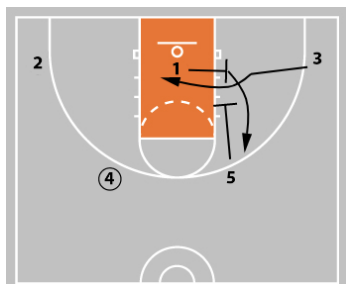
Thatís because the flex screen combined with the screen the screener action is quite difficult for defenses to guard.
It makes sense when you think about it...
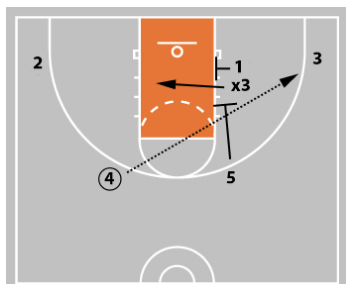
The flex screen alone is hard to guard.
If the defender guarding the cutter (x3), cheats too much over the screen. The cutter (3) can stand still and receive a skip pass for a wide open perimeter shot. And 1 can turn around and re-screen 3ís defender.
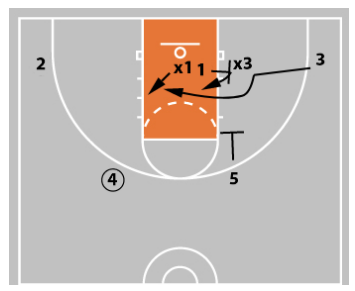
If the screenerís defender (x1) switches, then the screener (1) can seal the other defender (x3) for an easy shot inside.
If the cutterís defender (x3) plays honest, then they have to play the screen perfectly, so the cutter (3) doesnít receive a pass close to the basket.
It also puts tremendous pressure on the screenerís defender (x1). If they (x1) separate from the screener (1) too much to help on the cutter, the screener can quickly open up to the ball to receive a pass close to the basket. However, if they (x3) donít help enough, the cutter (3) can get an open basket.
Then while all of this is happening, a screen the screener action (5) occurs. So the screenerís defender (x1) has to make sure to help enough, so the cutter (3) doesnít get an easy basket. But donít help too much where they leave the screener (1) completely wide open. And they have to worry about another screen being set on them!
And even if the defense switches some or all of this action, you end up with poor post defenders on your best post players and poor perimeter defenders on your best guards.
That alone can create many scoring opportunities... This is part of the reason why so many high-level teams use this as a base action for their offense and plays!
These Additional Layers Make These Plays Lethal ...
Now when you disguise this flex offensive pattern with a common ball screen set, it shocks the defense. This enables you to get a couple of quick easy buckets before the defense adjusts... just from the flex pattern.
Now think about this additional layer...
As we mentioned, the flex pattern can be difficult to guard. And it can scramble the defense!
So when you add a highly effective play on the end of the flex pattern, like the plays we have for you below, youíre going to reap many scoring opportunities.
And letís pretend that the defense guards the flex pattern perfectly. Even great defenses will start to break down due to the plays that flow smoothly from the flex pattern.
And like many of you know, the flex pattern is extremely easy to teach and learn!
You will discover plays that create scoring opportunities in a variation of ways!
- Clear one side of the floor for a ball screen with your best ball handler
- Isolate your best post player while distracting help defense with misdirection
- Multi-scoring option plays with numerous ball screens and dribble hand offs
- Multiple plays for your best shooter that is sure to break down the defense
You are guaranteed to find at least one play that will help your team...
Set Plays From the Flex Horns Action
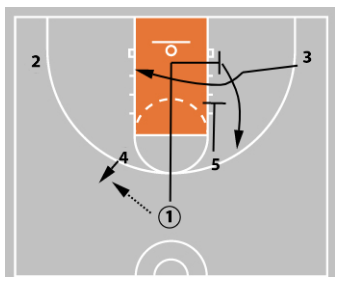
The next four plays start from this initial action.
Starting from the horns alignment, 1 passes to 4. Then 1 cuts to the rim.
4 can pass the ball if the cutter is open and get a quick layup.
In order to get the flex action started, 1 will set the flex screen for the 3 in the right corner.
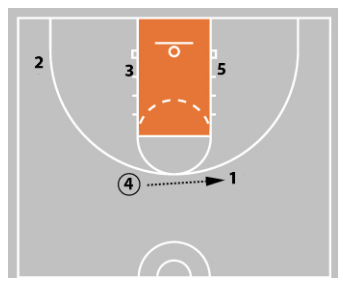
3 then cuts across the lane. At the same time, 5 sets a down screen for 1.
4 can pass to 1 if open.
But what if nobody is open!
3 wasnít open off the flex screen and 1 wasnít open for a shot off the downscreen.
You donít want to continue to run the flex pattern, so what else can you do?
Play #1 - Pass the ball inside to 5
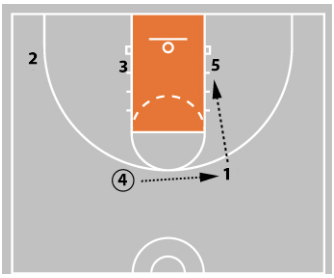
This is a simple, yet highly effective option. Shots from the post are some of the most efficient shots in basketball.
Once the ball is passed inside to 5, you can utilize a variety of actions and movements to space the floor and have rebounding position.
Play #2 - Step up screen
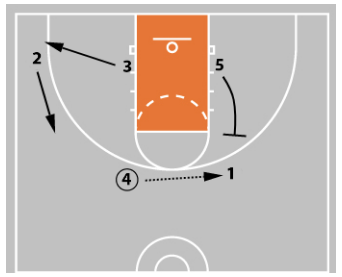
This is a great option if you have a ball handler who is good at attacking ball screens.
5 sets a step up screen for 1. Then 1 attacks looking to score. 5 makes the appropriate read where they can slip the screen, roll to the basket, pop to an open area, or rescreen for 1.
To balance the floor and create spacing, 2 and 3 move to spot up areas on the floor as the 2 man game occurs with 1 and 5.
Play #3 - Floppy action
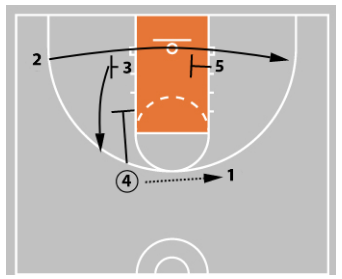
Hereís a play that is great for getting your best shooters an open look.
3 and 5 set staggered screens for 2.
4 then sets a screen for 3 to initiate a screen the screener action.
5 tries to seal the defense to gain an entry pass or better offensive rebounding position. If no scoring opportunity presents itself, they can flash to the high post.
Play #4 - Triple Screen
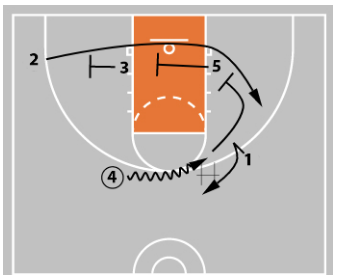
This is a great option to get your best shooter a wide open shot.
Instead of passing to 1, 4 initiates the action by dribbling to 1.
3 & 5 set staggered screens for 2. 3 and 5 start the screening action as the dribble handoff with 4 and 1 occurs.
After the dribble hand off to 1, 4 sets a third staggered screen for 2.
3, 5, and 4 should look to open up after setting the screen. At times, the defense can get confused and multiple defenders commit to guarding 2.
Play #5 - Horns Alternate Entry (Step Up Screen)
With this play, you use the horns formation again. However, the initial entry action is slightly different than the plays above.
The beauty of this alternate entry is that you can use all of the same four plays above. This will throw off any scouting reports and catch your opposition off guard. And your team can quickly and easily learn this entry.
You could install this new entry right before playoffs.
After the second diagram below, you simply replace the step up screen action with a post entry, floppy action, or triple screen.
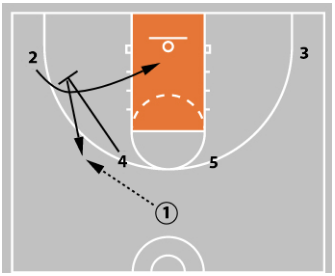
As you can see in the diagram, instead of using the point guard to set the initial flex screen, you use one of the corner players to start the offensive action.
4 sets a down screen for 2. 2 curl cuts to the basket.
4 shapes back towards the ball.
1 passes to 4.
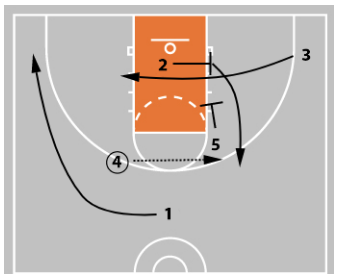
1 cuts to the left corner.
2 continues cut to opposite side of the floor and sets a flex screen for 3.
5 sets a screen for 2. (Screen the screener action.)
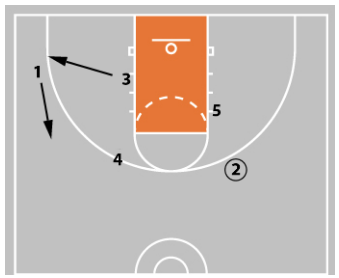
3 clears to the left corner.
1 shapes up to the left wing.
This clears one side of the floor and makes space for a ball screen action.
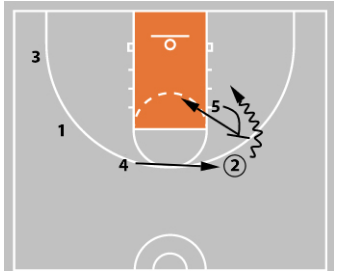
5 sets a step up screen for 2. Then 2 attacks looking to score.
5 rolls to the basket.
4 curls behind. This either removes 4ís defender as a help defender or leaves 4 wide open for a perimeter shot.
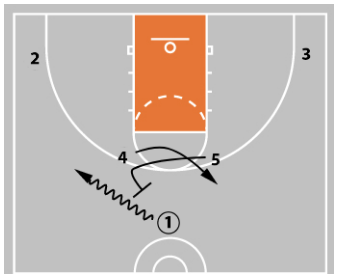
Play #6 - Horns DHO (Dribble Hand Off)
This action is very difficult to guard. The flex action serves as false action before your guard receives a double drag ball screen with the post.
This action is popular with international teams such as Lithuania.
4 & 5 cut diagonally.
5 sets a ball screen for 1.
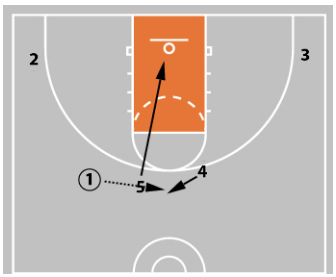
After the ball screen, 5 rolls to the basket.
1 quickly stops and passes the ball back to 4.
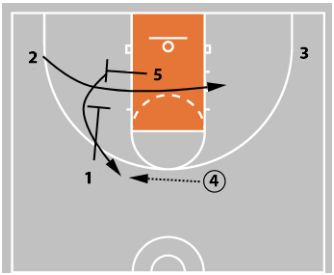
After the roll, 5 sets a flex screen for 2.
1 sets a down screen for 5.
4 passes to 5.
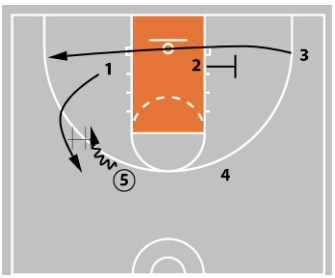
5 executes a dribble hand off with 1.
At the same time, 2 sets a flex screen for 3.
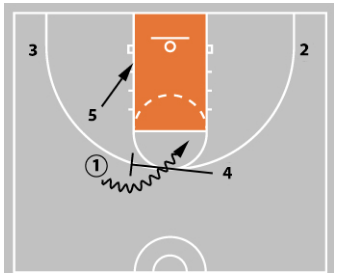
5 rolls to the basket.
4 sets a ball screen for 1.
These ball screen actions are very hard to guard!
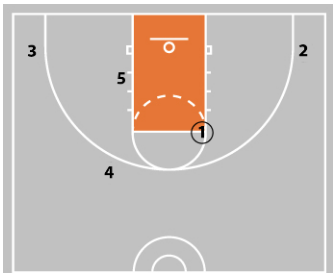
1 attacks and looks to score.
2, 3, 4, & 5 move to open areas for a kick out pass.
Play #7 - Flex Hammer Action
This play contains constant misdirection that leads to a wide open shot for your best shooter via the hammer action. There are also multiple scoring opportunities along the way including a backside lob to your post player.
The hammer action is a term used to describe a backside flare screen for a shooter.
Coach George Karl is credited for developing this action while coaching the Milwaukee Bucks and the San Antonio Spurs and have made it an integral part of their playbook.
Now you see the action utilized at the high school, college, and professional levels frequently.
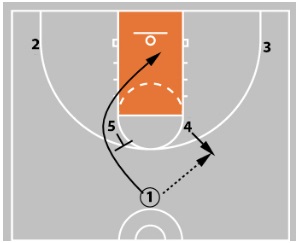
In the diagram, the offense starts in a Horns alignment with 4 popping out to receive the pass from 1.
1 cuts off 5ís screen to the rim for a possible layup if open.

5 steps out and 4 looks to reverse the ball to 5.
On the reversal to 5, you have the flex action.
1 screens for 3. 4 screens down for 1.
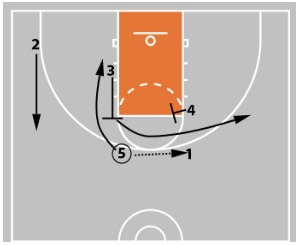
On the pass to 1 from 5, 3 now sets a back screen for 5 as 2 lifts up to the wing area.
3 then cuts across the lane off 4ís screen and receives the pass from 1.
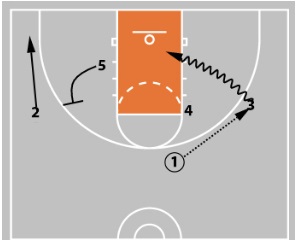
On the catch, 3 immediately drives the ball to the basket.
5 steps up from the low post position and sets a back screen on the defender guarding 2.
2 cuts to the corner and looks for the baseline drift pass from 3.
1 can fill behind 3ís penetration for a kick behind pass as well.
Play #8 - Flex Spain Action
Currently, one of the most popular offensive plays used is called the Spain Action.
This is a very difficult play to guard. It starts with the flex action and ends with a ball screen action that is followed by a back screen. When you combine these actions, an offensive advantage is sure to present itself.
This play gained prominence after the 2015 FIBA European Championships when Spain used it in the finals against Lithuania. Here is how teams use the flex to get into it.

1 passes to 5 popping out from a Horns alignment. 1 cuts to the rim.
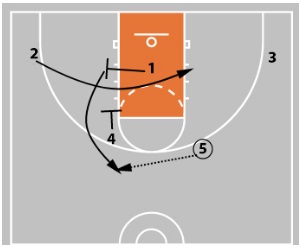
1 will set the initial flex screen for the player to set the back screen (in this example, player 2).
2 cuts across the lane as 4 screens down for 1.
5 passes to 1 as 4 fills the corner.
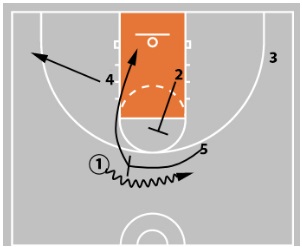
5 now sets a ball screen for 1.
1 comes off the screen as 2 sets the back screen on 5ís defender.
1 looks to pass to 5.
More Highly Effective Plays Utilizing Different Entries
Here are some more highly effective plays that donít start from the horns action, but still utilize the flex action.
Play #9 - Latvia Flex Lob Set
Here is a brilliant play from Latvia used against Spain during the FIBA European Championships. It gives your best post player multiple opportunities to score.
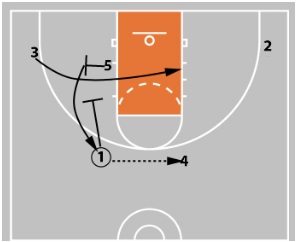
1 passes to 4 triggering the flex action.
3 cuts off 5 as 1 screens down for 5.
5 cuts to the top.
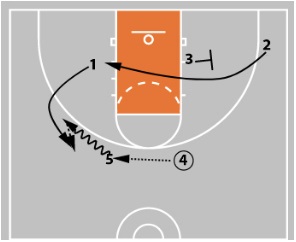
5 receives the reversal pass from 4.
5 now looks to hand the ball back to 1 coming around as 3 screens for 2.
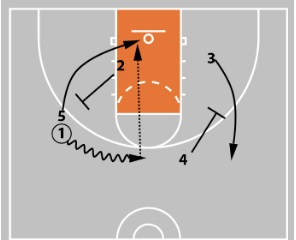
On the hand off to 1, 1 dribbles the ball to the middle as 2 cuts and back screens 5.
4 screens down for 3 to occupy the helpside defenders.
5 cuts to the rim and 1 throws the lob pass.
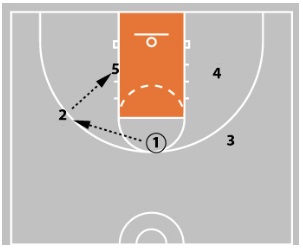
If 5 is not open for the lob, 1 can pass back to 2, who can look to shoot or throw the ball into 5 posting in the lane.
Play #10 - Flex Punch
This is a super simple play, yet is very effective if you have a decent post player.
The initial flex action is perfect for creating a post isolation due to the fact that the defense must guard the initial baseline screen to protect the basket.
And if the post entry is denied, it shows you a great counter to get your post player another scoring opportunity.
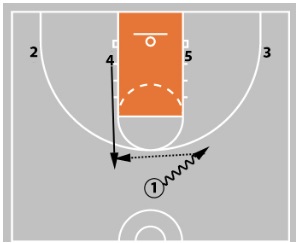
In this example, the offense starts in a 1-4 low alignment.
4 pops up to the top and receives the entry pass from 1.
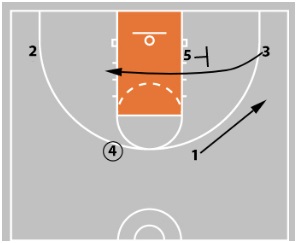
With the ball in 4ís hands, 3 cuts off 5ís screen as 1 slides down toward the wing area.
5 will step back toward the basketball after screening.
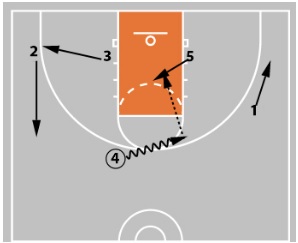
4 will use the dribble to improve the passing angle into 5.
To create space, 3 cuts to the corner and 2 cuts to the wing.
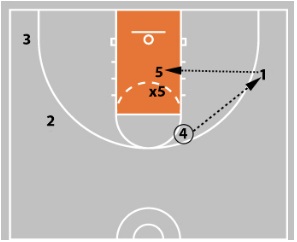
If 5ís defender is able to get above them to prevent the post entry pass, 4 now looks to pass the ball to 1, who now has a better passing angle into the post.
5 should seal the defender and keep them on the top side.
Hybrid Flex Offense
If you'd like to learn more about the flex offense and quick hitters you can use with it, take a look at Don Kelbick's Hybrid Flex Offense.
What do you think? Let us know by leaving your comments, suggestions, and questions...
|
||||||||||||



 Facebook (145k Followers)
Facebook (145k Followers) YouTube (152k Subscribers)
YouTube (152k Subscribers) Twitter (33k Followers)
Twitter (33k Followers) Q&A Forum
Q&A Forum Podcasts
Podcasts